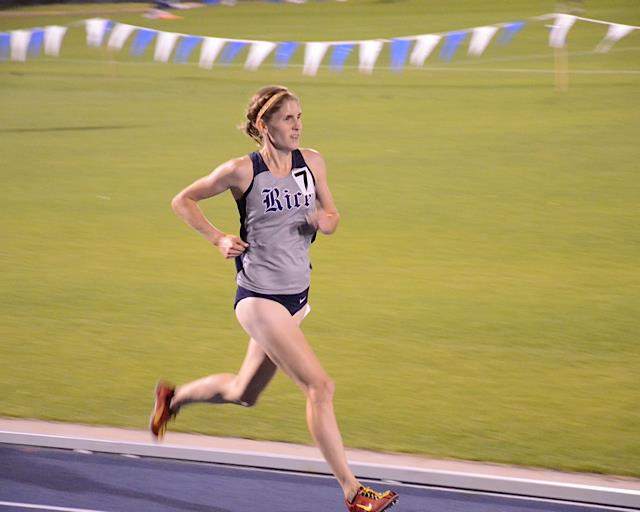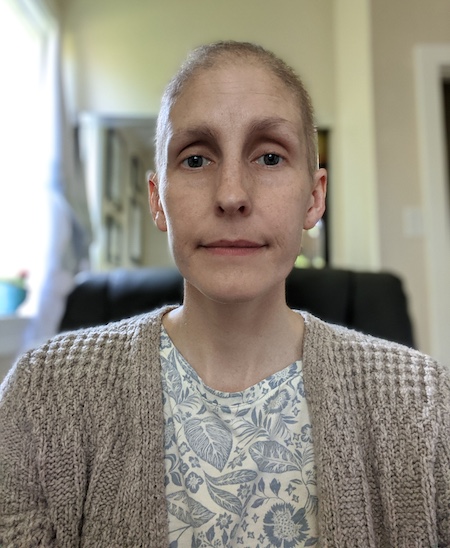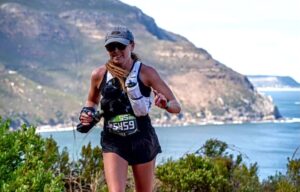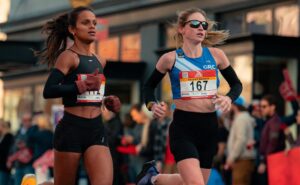
This is part three in an ongoing series about how runners’ relationships with the sport evolve over time, especially after their fastest years are behind them. Today’s story is about a runner who has endured more than most and gained a lot of wisdom in the process. (Here are parts one and two.)
As a collegiate runner for Rice University, Marie Thompson, 36, ran 17:03 for 5,000m and 35:13 for 10,000m. Now she celebrates being able to run for 10 or 15 minutes.
She once dreamed of breaking 3:00 in the marathon, or maybe even running an Olympic Marathon Trials qualifying time. But on her 30th birthday, a pathology report confirmed Thompson had late-stage esophageal cancer. After undergoing chemotherapy and major surgery, she has spent the past six years figuring out how to rebuild her life without the sport that used to be a major part of her identity.
As a teenager, Thompson took to running quickly. She was good at it, it gave her confidence, and provided a safe space for her to feel big emotions.
“It really became this basis for liking myself and part of my identity that was interwoven into every part of my personality. And therefore I took it super seriously,” she told Fast Women. “It just felt like a gift and something I would be damned if I didn’t try 120 percent every day to maximize my potential. I loved it, but there were certainly some really deep roots that I didn’t understand the tradeoffs around until I got sick.”
The opportunity to run for Rice was a dream come true for Thompson. She had an excellent experience on the team and she met some of her best friends. And she was thrilled to be in the top seven when the team qualified for the NCAA Cross Country Championships in 2010. She suffered her first serious setback her junior year, when she had a hip injury that took a long time to diagnose.
Thompson thinks that was the first big opportunity she had to separate her identity from running, but she did not take it. Instead, she “bulldozed through” and came back strong enough to make her fifth and final year of college running her best one. She finished her collegiate career in 2013, feeling like she didn’t have anything to prove. And she spent the next several years running most days, and doing some road racing.
Thompson felt a whole new world open up in running when she moved from Texas to the Bay Area to attend business school. She had greater access to trails and other wonderful places to run. And she was beginning to find her groove as a post-collegiate runner and was starting to think about bigger goals.
But in the summer of 2019, shortly after she graduated from business school, she had to stop running because she was feeling what she describes as a big resistance in her body. “Looking back at my journals, I was really mean to myself about it,” she said. “I was like, ‘What is wrong with you? Why can’t you just get out? It’s just three miles.’ But my body was telling me something.”
That was when she learned she had esophageal cancer, which came as a shock because it’s a cancer that mostly affects older men. Thompson had to stop running because she was sick from the cancer and the treatment, but also because she had surgery to remove much of her stomach and her esophagus. “I don’t have an esophageal sphincter anymore,” she explained, “so the risk of stomach acid damaging what was left of my esophagus was not worth it and not tolerated, especially right after cancer.”

Following treatment, she was down 20 pounds, anemic, and had to relearn how to eat and sleep. She also mourned the loss of her sport.
“I grieved running so much more deeply and for so much longer than I thought I would,” she said. “Part of me felt stupid to grieve something like running in a world where there’s deep injustice. But giving myself permission to grieve was a really big step.”
Thompson always knew running played a role in her mental wellbeing, but only after losing it did she realize how central it had been. The approach that had served her in the past—putting her head down and pushing through challenges—wasn’t going to work the way it once had.
“I really attached my value as a human being to things I achieved and things I produced,” she said. “And I think for a lot of my teens and 20s, it really served me more than it hurt me. But when I was diagnosed and my entire life imploded and I had no tools… I was forced to figure things out, and it was a pretty painful process.”
Thompson spent years trying to find something that will fill the role running played in her life. She has yet to find it, but she has found a strategy that has helped. She identified what specific things she liked about running—moving, being outside, being strong, being coached, listening to music, and spending time with friends—and has tried to meet some of those needs individually.
She has found that of the activities she can do, using an assault bike, a specific type of stationary bike, feels the most like running. To meet her need to go outside, she started doing evening walks and weekend hikes. She hired a personal trainer to fulfill her desire to feel strong and be coached.
“I feel like I’ve pulled the threads that together made running what it was,” she said. “The sum of the parts is not equal to what running was for me. All of these things together is maybe a 20 percent replacement.”
For years, Thompson has worked with a therapist who specializes in life-changing disease and has helped her recognize that she has value outside of what she achieves or produces. And that has allowed her to appreciate that 20 percent more.
“The ability to go into the gym and see myself getting stronger is beyond my wildest dreams of what I thought I could do post cancer,” she said. “It’s so energizing. So even though it isn’t running, I can at least tap into a higher level sense of what it means to be an athlete in a way that really starts to feed my soul.”
Thompson has come to terms with the fact that running can no longer be her main source of fitness. But since graduating from oncology in January, she has been able to reintroduce small amounts of running back into her life, 10 or 15 minutes once or twice a week. And when she’s out there, she’s not wishing she was faster, she’s just appreciating what she can do. “It’s just pure elation and an immense amount of gratitude,” she said. “The other day, I was like, ‘Thank you, legs. I know you ran 35:13 a lifetime ago, but I can’t believe we’re back here again.’”
Last month, to mark her 36th birthday and six years since her diagnosis, Thompson invited friends to do a track workout with her. Only one of them had run track previously, but they were enthusiastic to learn more about her “former life.” In college, she loved doing repeat 300s, so they did 4 x 300m followed by an all-out 300m, 200m, and 100m. Thompson couldn’t stop smiling the whole time. She wore her college track spikes, which she had recently found, and they lasted up until the final 100m when the soles fell off.
“It felt like a fitting end, like a track spike version of a Viking funeral,” she said. “My calves were also insanely sore for over a week and eventually I got sick from being run down, likely from pushing it a bit too much that day. But it was totally worth it—a real YOLO day.”
Thompson knows there’s a good chance that she will have to phase running back out at some point, but she’s appreciating what she has while she has it.

She still follows the sport, but for her peace of mind, she has to be selective about how she does so and who she follows. She attended last year’s Olympic Trials with one of her former college teammates and had a great time, but there were also some challenges. “I kind of felt like an alien because there’s so much community and casual fitness, and I can’t talk about running shoes,” she said. “I think it’s very fun to be in community with others on that, but I also feel very much outside of the typical running viewership.”
When reflecting on the running-related lessons she has learned from her struggles, Thompson offered the following advice: “Do the work to diversify your identity. Don’t wait until you’ve hit rock bottom. The trap I kept falling into is, ‘Well, I have running, so I don’t need to meditate.’ Or, ‘I don’t need to to go for mindfulness walks, be more intentional about talking to my friends, or find other ways to decompress and feel calm.’”
She says diversifying one’s identity could take many forms, but it might look like a runner identifying the season they enjoy running in the least and taking a step back and leaning into something else, socializing in a different way, or experimenting with a new hobby.
And for those who already can’t run or are afraid of losing their ability to run: “I think a big part of running is just tapping into yourself and digging deep,” she said. “And in your bones, you have tools to find a way through. It won’t be fun. For me, it was massively depressing and very hard. But it’s also not going to kill you. Give yourself space to grieve, maybe see a therapist, and keep trying and asking for help.”






